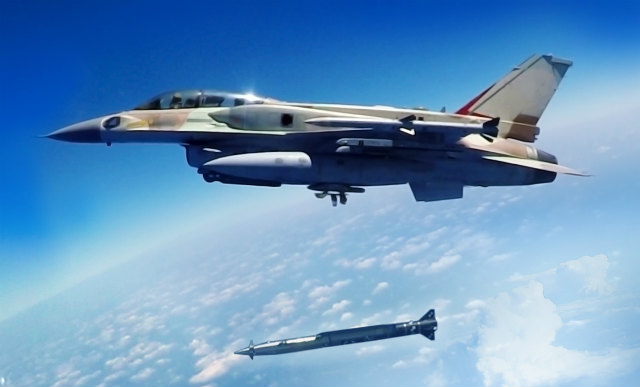A fighter pilot’s point of view.
The Israeli Air Force has reportedly started employing its new Rampage missile rocket in combat for the first time.
The new rocket, initially known as MARS (Multi-purpose, Air-launched Rocket System), is an air-to-surface missile developed by Israel Military Industries Systems (IMI Systems). It is a supersonic long-range all-weather day/night rocket with an advanced navigation suite which allows for precision targeting and very low mission cost compared to existing solutions.
The missile’s guidance and navigation system are a mix of an inertial measurement unit (IMU) with micro-electromechanical Systems (MEMS) technology combined with IAI’s ADA GPS/GNSS anti-jam system.
The initial precision rocket concept started from EXTRA project (EXTended Range Artillery) which is an artillery rocket system launched from fixed platforms.
The Rampage is expected to be employed in a stand-off scenario at a max range of about 55-60 NM (100+km).
One of the key factors to press for a low-cost and stand-off weapon with a rather quick employment in a real mission was probably the heavy Syrian Air Defense system and the Israeli F-16 shot down by a Syrian S-200 missile battery in February 2018.
Whatever led to the development of this weapon, there is a very, simple and strategic consideration: with the Rampage, the Israeli fighters would have a wide stand-off airspace over the Mediterranean Sea to attack ground targets in Syria while remaining outside the envelope of the Syrian Air Defense systems.
The missile employment is very similar to the last SMART and GPS bombs: in the pre-launch phase, the target coordinates are communicated from the launch aircraft to the missile navigation system. This phase is normally called ITA Initial Transfer Alignment and gives the pilot a read-out line about the navigation quality (in other words the precision) and the transfer status. After the pre-launch phase, the weapon can be launched (or dropped) in fire-and-forget mode: once the missile is in the air, it flies towards the predetermined coordinates and its trajectory is shaped and tailored to engage a target at a specific speed and angle. The fact that Rampage does not have a pure ballistic trajectory adds to its ability to penetrate and defeat heavily defended targets.
According to my experience as operational pilot and Advanced Fighter Jets Instructor, the launch phase seems to be quite similar to the one used to fire an Air-to-Air F&F (Fire And Forget) missile, when the pilot wants to increase as much as possible the range and the accuracy of the missile: in order to increase the range the pilot will pull upward (“loft”) just before pressing the fire button and will center the missile steering cue on the HUD in order to give the missile the best trajectory (with less maneuvers) to reach the predetermined coordinates. In the fighter community we use to call “Point, Climb, Shoot” and the photo of the Rampage being fired that has made the news (the one at the top of this article that is a screenshot from an IMI Systems video) shows just that: the 15-feet, 1,200-lb missile seconds after it was air-launched by a climbing F-16I.
During what’s believed to be first (and unconfirmed) raid of the Rampage in Syria, on Apr. 13, the missile was allegedly used to target warehouses and a rocket/missile factory at Masyaf, Syria:
#Israel Air Force successfully used #Rampage for first time. Due to the danger of #Syria Air Defense Force’s S-300PM-2s, #Israel Air Force had to use the rocket to target a rocket/ ballistic missile factory + weapon warehouses of #IRGC proxies in #Masyaf, #Syria on 13/04/2019: https://t.co/4YjD7ySZ5O
— Babak Taghvaee (@BabakTaghvaee) April 14, 2019
Provided they show the BDA of the first use of Rampage missiles, the satellite pictures seem to show extraordinary results: the Rampage’s navigation system characteristic and its ability to control and monitor the extent of its shrapnel allowed a surgical strike, awith minimum collateral damage despite the long flight time spent from launch to impact.
The Rampage has been designed for use against fixed targets such as radar sites, communications centres, weapons storage facilities and airfields, plus mobile threats.
Among the missile capabilities one of the most important add value to highlight is its flexibility to be carried by the most lethal Israeli aircraft like the F-16, F-15 and the F-35 (externally, since it’s too large to be carried in the weapons bay).









